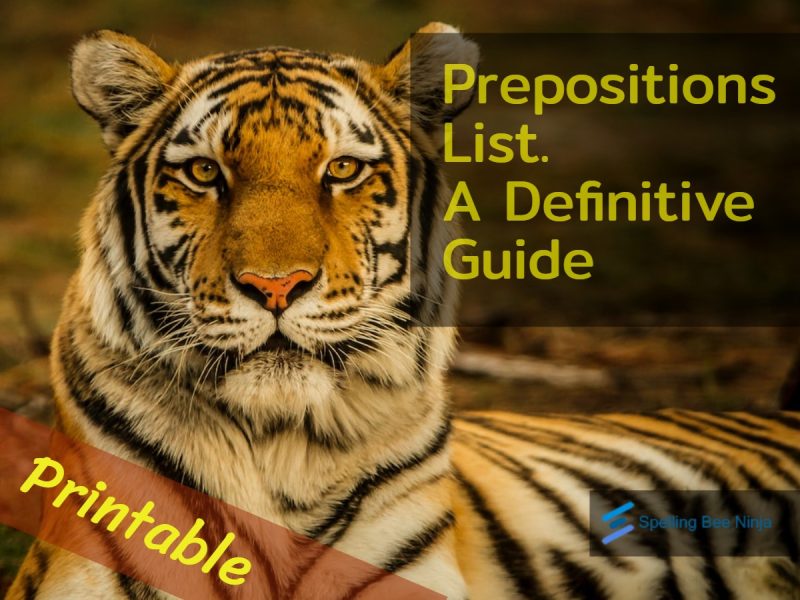A definitive guide to prepositions for the students struggling in this area. Also, we have provided an ultimate prepositions list for you to learn and boost your preposition.
Introduction to prepositions
Prepositional usage and meaning are seen by many students and even some teachers as a locked-door secret. However, using patterns and fundamental meaning concepts that emerge when we systematically investigate the syntactic surroundings of such important prepositions can help with explanation and learning.
When linking nouns, pronouns, and phrases to other words in a sentence, a preposition is a word or set of words that do this. Preposition includes singular words like in, at, on, of, to, by, and with as well as phrases like in front of, next to, and instead.
The majority of the time, English prepositions are determined by fixed expressions. There are a few broad rules to remember, although many prepositions are used idiomatically with certain verbs. In these situations, memorizing the entire phrase rather than each preposition is preferable.
In English, the prepositions at, in, and on are frequently employed to discuss times and places. Sometimes it appears random to choose one over another in a certain phrase or statement. The important concepts in meaning and usage that consistently apply and can be used as a platform for learning can be found, nevertheless, if we analyze patterns of occurrence.
Prepositions of time
In English, the prepositions in, at, and on are used with time. “On” indicates date and times, “at” typically shows the shortest time and location, and “in” normally means the biggest time or place.
Use of “at” in Clock times and celebrations
At 10:30, my last train departs.
Are you returning home at Easter or Christmas?
Use of “on” with days and dates
Lisa’s birthday is on December 18.
We usually go out on Saturday evening.
Use of “in” in a period
The van will be leaving in a few minutes.
I learned to ride a bike in 4 weeks.
Prepositions of place
It indicates the relationship between one thing or person and another. For example,
There is a plate on the table.
John sat beside Lisa.
He put the shoes under the table.
Preposition of direction
It describes the direction and movement of a person or item concerning other individuals or things.
“To” describes the movement from one place to another. For example
” We started walking to the river and back.”
“Towards” implies a specific direction. For example,
She flicks towards the mirror.
“Into” means to move towards something center.
He fell into well.
Prepositions list
The top 50 one-word prepositions are listed in the following brief list. Many of these prepositions might mean different things. Please consult a dictionary or click on each word for use and precise definitions.
Preposition: Learning tips
Because prepositions lack a clear definition—unlike nouns, adjectives, and adverbs—their use might be puzzling to students taking an online English course. The fact that most of them work in various contexts makes it more challenging to pick the right preposition. However, you might totally alter the meaning of your statements by choosing the wrong preposition.
Prepositions must be studied separately, which can be difficult but is the only way to learn them correctly.
- Prepositions from a learner’s native tongue should not be translated into English directly because they may have multiple equivalents in English. A dictionary for English language learners is a useful resource for learning which prepositions to use. For example “Oxford advanced learners dictionary” and “Merriam-Webster’s learner dictionary, but also our Spelling Bee Search Engine.
- Reading English language texts can also be useful for learning prepositional phrases and how to apply them in context. Identify all prepositions in the text of your choice, paying close attention to the noun or verb with which each preposition is associated. You can make your own flashcard to help you remember them by writing down the prepositional phrases and including an image that illustrates their usage.
- You can increase the range of prepositions in your vocabulary by paying close attention to how speakers in conversations, movies, music, and presentations utilize them. Conversely gets practice using the preposition in regular interactions with friends and students. You might initially concentrate on five prepositional phrases and gradually incorporate new ones As you get more at ease. It gets better faster.
Prepositions list: PDF, Flashcards and SBN formats
 | > Preposition words in PDF Format |
 | > Preposition words FLASHCARDS in PDF Format |
 | > Use Preposition words with our SBN APP |
Conclusion
Start with the simpler prepositions and progress to the more complex ones if you can get your skills in the best shape. Once you feel comfortable and as though prepositions are nothing more than a walk in the park, practice with worksheets a few times per week.
- ✈️ How to Use Articles in English
- 🐝 Mastering Adjectives: A Key to Enhancing Your Writing Skills
- 🎮 Pronoun Puzzle: A Fun Way to Practice Personal and Possessive Forms
- 🎮 Adjective Adventure: Descriptive Word Search!
- ✈️ How to use prepositions in English
- ✈️ English Adverbs – 5 Quick and Easy ways to learn.
- The definitive pronouns list
- 🐝 Understanding conjunction words and where to use them
- ✈️ Modal Verbs in English: A Comprehensive Guide
- 🐝 Prepositions list – The definitive guide
- ✈️ Active and Passive Voice
- ✈️ What vs Which: differences and examples
- 🐝 Complete transition words list
- ✈️ How to Use Punctuation in English
- ✈️ Exploring the Difference Between “Will” and “Shall” in English
- ✈️ The Difference Between Could, Should, and Ought in English
- ✈️ Common Idiomatic Expressions in English
- ✈️ 40 English Prefixes and their meanings
- ✈️ 30 Most common English suffixes and their meaning.
- 🐝 Linking Words In English And How To Learn Them Effectively
- ✈️ Comparative and Superlative Adjectives
- ✈️ The Six Noun Types (Common, Proper, Countable, Uncountable, Collective, Abstract)
- ✈️ Understanding English Clauses: A Complete Guide
- ✈️ Understanding Sentence Structure in English
- ✈️ Gerunds and Infinitives: Understanding Verb Complements in English
- ✈️ Common Pronunciation Mistakes and How to Fix Them
- ✈️ Question Formation in English
- ✈️ Common Sentence Errors: Fragments, Run-ons, and Misplaced Modifiers
- ✈️ Say What?! A Fun Guide to Direct and Indirect Speech
- ✈️ Commonly Confused Words
- 🐝 ELA vocabulary: Essential English Language Arts Terms Every Student Should Know
- ✈️ Formal vs. Informal Language
- ✈️ Mastering Phrases in English Grammar
- ✈️ Conditionals (Zero, First, Second, Third, Mixed Conditionals)
- ✈️ Emphasis and Inversion in Sentences
- ✈️ Understanding and Using the Imperative Form


